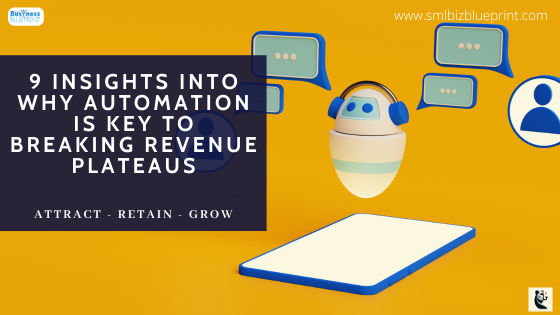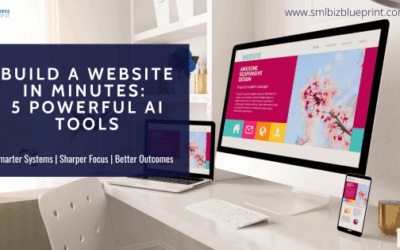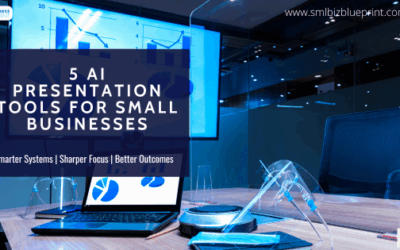Every business, no matter how successful, eventually hits a revenue plateau.
Growth slows, costs climb, and it seems that no matter how much effort is put in, the numbers refuse to budge.
It’s a frustrating reality for many business owners and managers, often stemming from inefficiencies, outdated processes, or a lack of scalability.
If this sounds familiar, you’re not alone.
Research shows that 77% of businesses experience growth stagnation due to operational inefficiencies and failure to adapt to new technologies.
The solution lies in automation for those looking to break free and scale up.
Automation is not just a buzzword; it’s a game-changer. By streamlining workflows, reducing costs, and unlocking productivity, businesses can finally overcome those roadblocks and create sustainable growth.
In this post, we’ll explore how automation can help your business breakthrough revenue plateaus, focusing on key areas like sales, marketing, customer service, and data analysis.
You’ll discover practical strategies, real-world success stories, and the tools you need to implement automation without breaking the bank.
Ready to transform your business? Let’s dive in.

#1 What Is a Revenue Plateau and Why Does It Matter?
A revenue plateau occurs when a business’s income stagnates despite consistent or increased efforts. It’s a critical stage in business growth that signals something isn’t working as it should.
This stagnation often stems from operational inefficiencies, outdated systems, or a lack of innovation, preventing businesses from scaling effectively.
For small to medium-sized businesses, these plateaus can be particularly frustrating. You’re working harder than ever, yet your profits remain stagnant, costs keep rising, and your team’s morale drops.
Without intervention, revenue plateaus can lead to long-term challenges such as reduced cash flow, loss of market share, and an inability to meet customer expectations.
Recognising the early warning signs is essential to addressing the issue before it escalates:
- Flatlining Growth: Despite increased marketing or sales efforts, revenue remains unchanged.
- High Operating Costs: You’re spending more to achieve the same results.
- Customer Churn: Difficulty retaining customers due to inconsistent service or lack of personalised engagement.
Breaking through a revenue plateau requires rethinking traditional processes. It’s often about working smarter, not harder.
Automation offers a powerful remedy by addressing inefficiencies, reducing manual workload, and unlocking resources to focus on strategic growth.
Tips
Audit Your Current Operations: Identify time-consuming tasks, bottlenecks, and areas where resources are being overutilised. These are prime candidates for automation.
Focus on Quick Wins: To build momentum and demonstrate ROI, start by automating one or two small processes, such as email marketing campaigns or customer follow-ups.
Track Key Metrics: Monitor revenue growth, customer retention rates, and operational costs to measure the impact of automation over time.
By recognising the plateau and taking proactive steps to address it, you can unlock new growth opportunities and position your business for long-term success.
#2 The Key Role of Automation in Overcoming Revenue Stagnation
Revenue stagnation often results from processes that can’t keep pace with growth.
Repetitive tasks, manual workflows, and outdated systems consume valuable time and resources, leaving businesses stuck in a cycle of inefficiency.
Automation addresses these challenges head-on by streamlining operations, enhancing accuracy, and freeing your team to focus on high-impact activities.
Automation transforms how businesses operate in several ways:
- Streamlining Workflows: Automation tools can handle repetitive tasks like data entry, appointment scheduling, or invoice processing, reducing errors and speeding up operations.
- Enhancing Customer Experience: Automated systems such as chatbots and personalised email campaigns ensure consistent, timely communication with your customers.
- Boosting Scalability: Unlike manual processes, automated workflows can grow with your business without requiring proportional increases in costs or resources.
Take customer service as an example: Automation tools like chatbots can handle 80% of common customer queries, allowing your team to focus on complex or high-priority cases.
This improves customer satisfaction and reduces operational strain, enabling your business to deliver better results with fewer resources.
Tips
Start Small with High-Impact Areas: Identify bottlenecks in your business that consume the most time and resources, such as manual customer follow-ups or invoicing.
Invest in Scalable Tools: Choose automation tools, such as CRM systems or marketing automation platforms, that can grow alongside your business.
Monitor and Optimize: Continuously track the performance of automated processes and refine them to maximise efficiency and ROI.
By embracing automation, businesses can break free from the constraints of outdated workflows and achieve the scalability needed to overcome revenue plateaus.
Want to Stay Ahead of the Competition?
Join our newsletter for expert-driven insights, tools, and tips to help you grow your business.
#3 5 Business Processes That Benefit Most from Automation
Automation isn’t a one-size-fits-all solution—it’s most impactful when applied strategically to processes that consume time, require repetitive actions, or are prone to human error.
Focusing on these high-value areas can help businesses regain momentum and overcome revenue stagnation.
Here are five key processes that can benefit the most from automation:
- Sales Processes
Manually tracking leads, sending follow-ups, and updating CRM systems can drain your sales team’s time and energy. Automation streamlines these tasks, ensuring no lead falls through the cracks and your sales pipeline flows efficiently.
For instance, automated email sequences can nurture prospects, while CRM integrations ensure timely updates.
- Customer Service
Responding promptly to customer inquiries is critical to retention, but maintaining 24/7 service can strain resources. Automation tools like chatbots and automated ticketing systems handle routine questions and escalate complex issues to human agents.
This not only improves response times but also enhances customer satisfaction.
- Marketing Campaigns
From email marketing to social media scheduling, automation simplifies campaign management. Tools can segment audiences, personalise communication, and track campaign performance, freeing up your marketing team to focus on strategy and creative work.
- Data Analysis and Reporting
Manual data processing is time-consuming and prone to errors. Automation tools like dashboards and AI-driven analytics software can gather, analyse, and present real-time insights.
This enables faster decision-making and helps identify growth opportunities.
- Inventory and Supply Chain Management
For businesses that sell physical products, automation tools can optimize inventory levels, track shipments, and predict demand. This reduces overstocking or understocking issues, saving time and money.
According to a Deloitte survey, 53% of businesses report improved productivity as the primary benefit of automating critical processes like sales and customer service.
Tips
Prioritise Pain Points: Start with processes that are time-consuming or frequently prone to human error.
Invest in Integration-Friendly Tools: Ensure the automation tools you choose can seamlessly connect with your existing systems, such as your CRM or ERP software.
Evaluate ROI Continuously: Regularly assess the time and cost savings from automation to identify further optimisation opportunities.
By automating these core processes, businesses can unlock efficiency, improve customer satisfaction, and set the stage for sustainable revenue growth.
#4 How Automation Can Improve Profit Margins and Boost Efficiency
Maintaining profitability is one of the greatest challenges for businesses stuck in a revenue plateau. As operating costs rise, profit margins shrink, making it harder to allocate resources for growth.
Automation addresses this challenge by reducing operational costs, minimising errors, and increasing productivity, enabling businesses to do more with less.
Cost Reduction Through Automation
Automation eliminates repetitive manual tasks, reducing labour costs without compromising output. Tasks such as data entry, invoicing, and scheduling can be streamlined using tools like Make or QuickBooks.
This saves money and allows employees to focus on high-value activities like strategy and innovation.
Error Reduction and Consistency
Human errors in data entry or customer communication processes can lead to costly consequences. Automation ensures accuracy and consistency, minimising mistakes and the need for rework.
For instance, automated reporting tools reduce inaccuracies in financial statements, saving businesses significant amounts in rectification costs.
Increased Productivity Without Additional Resources
Businesses can handle higher workloads by automating processes without adding staff or investing in extra infrastructure.
Marketing automation platforms like HubSpot or customer service tools like Zendesk can manage large volumes of tasks while maintaining quality, allowing teams to scale their efforts efficiently.
According to PwC, businesses implementing automation in core processes experience a 15% reduction in operational costs and a 20% increase in productivity within the first year.
Tips
Start with High-Cost, Low-Efficiency Areas: Identify processes such as payroll or order processing where automation can immediately reduce expenses.
Measure Savings and Reinvest: Track cost savings achieved through automation and reinvest them into growth initiatives like marketing or technology upgrades.
Combine Automation with Training: Train your team to work alongside automated systems, ensuring they can maximise the tools’ capabilities for greater efficiency.
By automating key aspects of your operations, you can significantly reduce costs, improve margins, and position your business for scalable growth.

#5 Data Analysis Automation: Identifying and Solving Revenue Bottlenecks
Revenue plateaus often stem from hidden inefficiencies and missed opportunities that are difficult to uncover with manual processes.
Automating data analysis allows businesses to quickly identify these bottlenecks, enabling faster, more informed decision-making to address the root causes of stagnation.
Real-Time Insights for Informed Decisions
Traditional data analysis methods can take days—or even weeks—delaying critical actions. Automated data tools provide real-time insights into sales trends, customer behaviours, and operational inefficiencies.
For example, platforms like Tableau or Power BI allow businesses to visualise and track performance instantly, helping them pinpoint underperforming areas.
Identifying Revenue Bottlenecks
Automation excels at analysing large datasets to identify patterns and often overlooked problems.
It can uncover bottlenecks such as:
- High customer churn rates caused by poor support.
- Slow sales conversion rates due to inefficiencies in lead nurturing.
- Excess inventory buildup leading to increased costs.
Businesses can optimise workflows and redirect efforts toward revenue-generating activities by addressing these bottlenecks.
Forecasting and Predictive Analytics
Automated tools powered by AI and machine learning provide predictive insights into future trends. Businesses can forecast demand, identify seasonal spikes, and prepare for market shifts, ensuring they stay ahead of the competition and maximise profitability.
Tips
Invest in User-Friendly Tools: Choose data analysis platforms like Google Analytics, Tableau, or Power BI that are accessible and integrate seamlessly with your current systems.
Set Clear Metrics and KPIs: Focus on analysing data that directly impact revenue, such as customer acquisition cost (CAC), average order value (AOV), and conversion rates.
Leverage Predictive Analytics: Use AI-driven tools to forecast trends and proactively address potential challenges before they impact revenue.
By automating data analysis, businesses can quickly identify revenue bottlenecks and implement targeted solutions to drive growth and overcome plateaus.
#6 Top Automation Tools to Scale Your Business Without Breaking the Bank
Investing in automation doesn’t mean overhauling your entire operation or draining your budget. Today’s automation tools are more affordable and scalable than ever, making it easier for businesses of all sizes to unlock efficiency and growth.
The key is selecting the right tools that align with your business needs and goals.
- CRM Systems for Sales and Customer Management
Customer Relationship Management (CRM) platforms like HubSpot or Salesforce streamline sales pipelines and customer interactions. These tools automate tasks such as lead tracking, follow-ups, and customer segmentation, allowing your sales team to focus on closing deals.
- Marketing Automation Platforms
Marketing tools like Mailchimp or ActiveCampaign enable businesses to automate email campaigns, social media scheduling, and audience targeting. These platforms personalise communication at scale, helping businesses maintain customer engagement without extra manual effort.
- Workflow Automation Solutions
Workflow tools like Zapier and Make (formerly Integromat) connect apps and automate repetitive tasks. For example, you can set up a workflow that automatically saves customer inquiries from your website into a spreadsheet or CRM for quick follow-up.
- Data and Analytics Platforms
Tools like Tableau, Google Analytics, and Power BI automate data collection and visualisation, helping businesses monitor performance and make real-time informed decisions.
These tools are especially valuable for tracking revenue trends and identifying areas for improvement.
Tips
Start with Free or Low-Cost Options: Many tools, such as Mailchimp or HubSpot, offer free plans for small businesses. Test these features before upgrading to premium versions.
Focus on Integration: Choose tools that integrate seamlessly with your existing software to create a unified workflow.
Scale Gradually: Begin with automating a single process, such as email marketing or lead tracking, to demonstrate ROI before expanding to other areas.
Choosing cost-effective automation tools that align with your business goals can enhance efficiency, reduce workload, and prepare for scalable growth without stretching your budget.
Get Monthly Marketing and Business Insights to Drive Real Growth—All for Just $7/Month!
Unlock actionable strategies, AI insights, and expert tips to keep your business ahead—all delivered to your inbox for the price of a coffee.
Subscribe to Pulse today
#7 Measuring Success: How to Calculate the ROI of Business Automation
Implementing automation is a powerful way to overcome revenue plateaus, but how do you know it’s working?
Measuring the return on investment (ROI) is crucial to understanding the effectiveness of your automation efforts.
It helps you track cost savings, productivity improvements, and revenue growth, ensuring you’re maximising the impact of your tools.
- Defining ROI for Automation
ROI measures the profitability of your investment in automation tools and processes. It’s calculated using the formula:
ROI = (Benefits – Costs) / Costs
For example, if you invest $10,000 in automation and save $30,000 annually in operational costs, your ROI would be 200%.
- Tracking Key Metrics
To accurately measure ROI, focus on the metrics that matter most to your business. These might include:
- Operational Cost Savings: Compare pre- and post-automation expenses.
- Productivity Gains: Measure time saved on repetitive tasks.
- Revenue Growth: Track increases in sales or customer lifetime value resulting from automation.
- Error Reduction: Quantify improvements in accuracy, such as fewer customer complaints or refunds.
- Continuous Monitoring for Long-Term Results
Automation ROI isn’t a one-time calculation. Businesses must regularly monitor their tools and processes to ensure sustained benefits.
Use dashboards or analytics software to track performance and identify areas for further optimisation.
Tips
Set Clear Goals Before Implementation: Define what success looks like for your business, whether it’s reducing costs, improving customer retention, or increasing revenue.
Leverage Analytics Tools: Use automation platforms that provide built-in analytics to simplify tracking and reporting on ROI.
Reinvest Savings: To multiply the benefits, allocate the cost savings from automation into high-growth areas like marketing, product development, or employee training.
By measuring and optimising the ROI of your automation efforts, you can ensure that each investment drives tangible value and contributes to breaking through revenue plateaus.
#8 Common Automation Mistakes and How to Avoid Them
Automation has the potential to revolutionise business operations, but implementing it without proper planning can lead to more problems than solutions.
To maximise its benefits, it’s essential to avoid common pitfalls that could derail your automation efforts.
- Over-Automating Processes
While automation can save time and reduce costs, over-automating can strip your business of its personal touch. Relying solely on automated email responses without human follow-ups may alienate customers who prefer personalized interactions.
It’s crucial to strike the right balance between automation and human input.
- Lack of Training and Adoption
Automation tools are only as effective as the people using them. Many businesses invest in complex software without adequately training their teams, leading to underutilisation or improper implementation.
This results in wasted resources and frustration among employees.
- Choosing Tools That Don’t Integrate
Selecting standalone tools that don’t integrate with your existing systems can create inefficiencies rather than solve them.
For example, using a marketing automation platform that doesn’t sync with your CRM can lead to fragmented workflows and duplicated efforts.
Tips
Start Small: Automate a single process—such as email marketing or lead tracking—first to test its effectiveness and refine your strategy before expanding.
Involve Your Team: Provide thorough training and gather feedback from employees using the tools to ensure adoption and proper usage.
Focus on Compatibility: Choose automation tools that integrate seamlessly with your current software and workflows to create a cohesive system.
By avoiding these common mistakes and implementing automation thoughtfully, you can ensure smoother operations, higher adoption rates, and better results from your automation initiatives.
#9 Future-Proofing Your Business with AI-Powered Automation
Integrating artificial intelligence (AI) into your processes is becoming a game-changer as automation evolves.
AI-powered automation goes beyond simple task management—it adapts, learns, and provides personalised insights that help businesses stay competitive in an ever-changing market.
- Personalization at Scale
AI enables businesses to deliver tailored customer experiences by analysing vast amounts of data. Tools like Dynamic Yield or Adobe Sensei use AI to recommend products, personalise email campaigns, and adapt website content in real time based on user behaviour.
This level of personalisation builds stronger customer relationships and drives sales.
- Real-Time Decision-Making
Unlike traditional automation, AI can make decisions instantly by processing complex data sets. This is especially useful in industries like logistics and finance, where split-second decisions can significantly impact operations.
Predictive analytics tools like IBM Watson provide actionable insights that help businesses optimise processes and seize opportunities.
- Adapting to Emerging Trends
AI-powered automation is future-proof because it evolves with your business. Machine learning algorithms improve over time, enabling your systems to handle new challenges and deliver better results.
Whether analysing market trends or managing customer queries, AI helps businesses stay ahead of the curve.
Tips
Start with AI-Enhanced Tools: Use platforms that combine traditional automation with AI capabilities, such as chatbots powered by natural language processing or marketing platforms with predictive analytics.
Focus on High-Impact Areas: Deploy AI in processes where it can provide the greatest ROI, such as customer service or supply chain management.
Continuously Monitor and Adapt: AI systems improve over time but require regular evaluation to ensure they align with your business goals and adapt to changing market needs.
By embracing AI-powered automation, businesses can overcome current revenue plateaus and position themselves for long-term growth and innovation in a competitive landscape.
Conclusion
Hitting a revenue plateau can be frustrating, but it’s also an opportunity to rethink and reinvent how your business operates. As we’ve explored, automation offers a powerful solution by streamlining processes, reducing costs, and unlocking scalability.
From improving sales and marketing efficiency to leveraging AI for real-time decision-making, automation can transform your business into a leaner, more productive, and future-ready operation.
Key takeaways:
- Identify revenue bottlenecks: Use automation to pinpoint inefficiencies and optimize your workflows.
- Focus on impactful areas: For quick wins, start with processes like customer service, marketing, or data analysis.
- Leverage AI-powered tools: Future-proof your business by adopting AI-driven automation for personalised customer experiences and predictive insights.
- Measure success: Continuously track ROI and adapt your automation strategy to maximize long-term growth.
Automation is not just about saving time; it’s about creating opportunities to focus on strategic growth and innovation.
By implementing the strategies and tools outlined in this post, your business can break through revenue plateaus and achieve sustainable success.
Ready to take the next step?
Start small—automate one key process today and experience the difference it makes.
Explore tools, plan your implementation, and transform your business operations. The growth you’ve been striving for is within reach.
FAQs
Q1: What is a revenue plateau, and how does it impact businesses?
A1: A revenue plateau occurs when a business’s income stagnates despite efforts to grow. This can lead to reduced profitability, higher operational costs, and difficulties scaling. Addressing a plateau often requires identifying inefficiencies and implementing solutions like automation to optimise operations.
Q2: How can automation help a business break through a revenue plateau?
A2: Automation streamlines repetitive tasks, reduces errors, and improves productivity, allowing businesses to focus on strategic growth. It enhances efficiency in areas like sales, customer service, and data analysis, which can drive revenue growth and profitability.
Q3: What are the best business processes to automate first?
A3: Key areas to prioritise for automation include:
Sales (e.g., CRM and lead nurturing)
Customer service (e.g., chatbots and ticketing systems)
Marketing (e.g., email campaigns and social media scheduling)
Data analysis (e.g., reporting and dashboards)
Inventory management (e.g., demand forecasting).
Q4: How do I measure the ROI of automation in my business?
A4: To calculate ROI, use the formula:
ROI = (Benefits – Costs) / Costs
Track metrics such as operational cost savings, time saved, error reduction, and revenue growth. This ensures you can assess whether your automation efforts are driving measurable results.
Q5: What are common mistakes to avoid when implementing automation?
A5: Some common pitfalls include over-automating processes, failing to train employees, and choosing tools that don’t integrate with existing systems. Starting small, involving your team, and focusing on scalable tools can help avoid these issues.
Q6: What tools are best for business automation?
A6: Some popular tools include:
HubSpot for CRM and marketing automation.
Zapier for connecting apps and workflows.
Tableau for data visualisation.
Mailchimp for email marketing.
Zendesk for customer service automation.
Q7: Why should I consider AI-powered automation for my business?
A7: AI-powered automation adds advanced capabilities like real-time decision-making, predictive analytics, and personalised customer interactions. This helps businesses stay competitive, adapt to market changes, and scale efficiently.
Q8: Is automation suitable for small businesses?
A8: Yes, many affordable and scalable automation tools are designed specifically for small businesses. These tools help reduce workload, improve efficiency, and drive growth without requiring significant upfront investment.
Other Articles
15 Must-Do Digital Marketing Essentials to Boost Your Year-End Results
Using Benchmarking to Improve Small Business Performance
How To Make Predictive Analysis Worthwhile For Your Small Business




